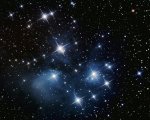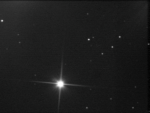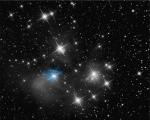You are using an out of date browser. It may not display this or other websites correctly.
You should upgrade or use an alternative browser.
You should upgrade or use an alternative browser.
Astronomy / Space My Pleiades pic...
- Thread starter HailVectron
- Start date
I want the ceiling of my bedroom like this
I watched that BBC4 doc about stars that is mentioned in this board actually, and they said that the first dinosaurs wouldn't have seen these stars, because they hadn't been born yet! So I'm assuming all that dust around them will end up forming into the planets over the next few billion years...
I watched that BBC4 doc about stars that is mentioned in this board actually, and they said that the first dinosaurs wouldn't have seen these stars, because they hadn't been born yet! So I'm assuming all that dust around them will end up forming into the planets over the next few billion years...
https://en.wikipedia.org/wiki/PleiadesThe cluster is dominated by hot blue and extremely luminous stars that have formed within the last 100 million years.
https://en.wikipedia.org/wiki/Evolution_of_dinosaursDinosaurs evolved within a single lineage of archosaurs 232-234 Ma (million years ago) in the Ladinian age, the latter part of the middle Triassic.
I tend to be a bit sceptical about the BBC these days, but a quick check shows that it was actually correct.
Thanks for the info. I never realised that and thanks for the great Picture.
Somehow it puts me in mind of the Phoenix Asteroid from the film, Dark Star.
Amazing work. You got good detail out of it and your tracking is almost perfect. What equipment did you use and what were the exposure times ?
A long time ago now, but IIRC it was an 80mm ED refractor with a Canon 300D. 6 or 8 minute frames (can't remember how many), all on an autoguided EQ6 mount.
A long time ago now, but IIRC it was an 80mm ED refractor with a Canon 300D. 6 or 8 minute frames (can't remember how many), all on an autoguided EQ6 mount.
Cool, I got a Skywatcher ED 80 and a Canon 1000D, but haven't modified the camera with a UV pass sensor. I wanted to get an HEQ 5 Pro mount to replace my old EQ-5 one.
A long time ago now, but IIRC it was an 80mm ED refractor with a Canon 300D. 6 or 8 minute frames (can't remember how many), all on an autoguided EQ6 mount.
I don't think that could have been taken with a refractor due to the diffraction spikes on the stars. Almost certainly a Newt. Lovely pic though.
(For non-astronomers, the spikes on the stars are caused by the four mounting posts (spider) of the secondary mirror on a Newtonian reflector. Refractors don't exhibit this because they use lenses, nor do Schmidt Cassegrain or Maksutov scopes because the secondary mirror is mounted on a glass plate)
Last edited:
I don't think that could have been taken with a refractor due to the diffraction spikes on the stars. Almost certainly a Newt. Lovely pic though.
(For non-astronomers, the spikes on the stars are caused by the four mounting posts (spider) of the secondary mirror on a Newtonian reflector. Refractors don't exhibit this because they use lenses, nor do Schmidt Cassegrain or Maksutov scopes because the secondary mirror is mounted on a glass plate)
It can if you use a Photoshop plugin to put on diff spikes
My 10" newt doesnt have the FOV to get the whole Plaeides in, so I'm pretty sure it was my 80mm ED...
Odd, isn't it, that star field pics look so much better with diffraction spikes. Never knew you could use Photoshop to add them (use Gimp myself)
Dark skies ;-)
Dark skies ;-)



